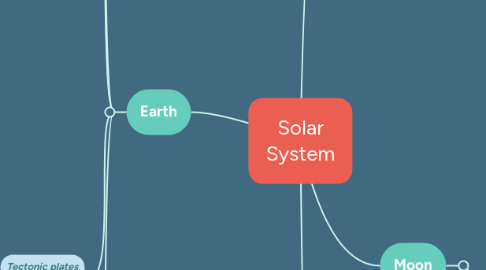
1. Earth
1.1. Earth’s Structure
1.1.1. Nucleus
1.1.1.1. Internal Nucleus:
1.1.1.1.1. (Around 5000°C), it is solid because of the great pressures that the superior layers exert on it. It is composed mainly of nickel and iron.
1.1.1.2. External Nucleus:
1.1.1.2.1. It is liquid and presents ascendant and descendant convective movements that produce electric currents, what in turn is the basis of the Earth’s magnetic field. It is composed mainly of molten iron, nickel, sulfur and silicon.
1.1.2. Mantle
1.1.2.1. Lower mantle
1.1.2.1.1. Is mainly composed of iron silicates and is solid.
1.1.2.2. Upper mantle
1.1.2.2.1. it is located just below the Earth’s crust and is separated from it by the Mohorovicic discontinuity. It contains solid elements, called magma.
1.1.3. Crust
1.1.3.1. Oceanic crust:
1.1.3.1.1. asaltic rocks predominate. The oceanic crust covers the upper mantle and is the seat of the continental cortex.
1.1.3.2. Continental crust:
1.1.3.2.1. Its thickness has barely 35 kilometers, Granitic rocks predominate. They are found over the oceanic crust and the basaltic rocks.
1.1.4. Lithosphere
1.1.4.1. Earth’s outermost layer, It is formed by 16 tectonic plates that move above asthenosphere. It supports the lithosphere. Here is where the volcanic eruptions and earthquakes happen.
1.2. Earth´s movements
1.2.1. Rotational movement,
1.2.1.1. The Earth moves around the polar axis following a west to east direction, and this causes the Sun to rise on the east (orient) and to set on the west (occident). The exact duration is called a sidereal day, and lasts exactly 23 hours, 56 minutes and 5 seconds; but, the day is adjusted to 24 hours in what we call a civil day.
1.3. Revolutionary movement
1.3.1. Follows an elliptical orbit around the Sun. The whole loop is completed in 365 days, 5 hours and 48 minutes, and starts on March 21st, determines the seasons of the year.
1.4. Tectonic plates
1.4.1. Earth landscape
1.4.1.1. Is formed by the plate collisions. These collisions are endogenous factors
1.4.1.1.1. Mountains
1.4.1.1.2. Plateaus
1.4.1.1.3. Plains
1.4.2. Volcanism
1.4.2.1. Collisions between plates create cracks through which magma and other solid and liquid elements are expelled to the Earth’s surface.
1.4.2.1.1. Volcano parts
1.4.3. Seismicity
1.4.3.1. An earthquake is the result of the collision between two tectonic plates, their displacement or rearrangement. These movements release energy in the form of seismic waves. The point where the earthquake originates is called the hypocenter or focus, and the point directly above the hypocenter and over the Earth’s crust is called the epicenter.
1.4.3.1.1. Ways to measure an earthquake:
1.5. Geological eras
1.5.1. Precambrian
1.5.1.1. It started approximately 4 billion years ago, when the Earth’s crust started to solidify because of the rain’s action on the hot rocks, and ended 570 million years ago.
1.5.2. Paleozoic
1.5.2.1. The continents Laurasia and Gondwana collide with one another to form a supercontinent called Pangea. At the end of this era, the seas receded. The first vertebrates appeared.
1.5.3. Mesozoic
1.5.3.1. Pangea continues breaking down and the Earth’s crust stretches. The sinking of big land masses and the creation of basins. Dinosaurs reigned during this era, although birds and primitive mammals also appeared.
1.5.4. Cenozoic
1.5.4.1. The continents have the present conformation. This era is dominated by mammals, among them the primates.
1.5.5. Quaternary
1.5.5.1. The subsequent thaw caused the sea level to rise between 30 or 40 meters. The Homo sapiens has been dominating the Quaternary.
2. Sun
2.1. Sun layers
2.1.1. Core
2.1.1.1. Powers the sun and produces the heat and light we receive on Earth.
2.1.2. Radiactive zone
2.1.2.1. Energy from the Core is carried out by radiation in the form of gamma and X rays.
2.1.3. Convective cone
2.1.3.1. Energy is transmitted by convection, large bubbles of hot plasma move upwards.
2.1.4. Photosphere
2.1.4.1. Most of the Sun’s radiation escapes outwards and is detected as the sunlight we observe on Earth about eight minutes after it leaves the Sun.
2.1.5. Chromosphere
2.1.5.1. It is the atmosphere of the Sun and it is formed by incandescent gases.
2.1.6. Corona
2.1.6.1. It is the outermost region and can be seen as a beautiful silver white crown around the Sun with plasma streaming outside.
3. Moon
3.1. Moon phases
3.1.1. New Moon
3.1.1.1. The Moon is in the new phase when a new cycle starts, every 29 days. In New Moon, the Sun and the Moon rise the same day at the same time.
3.1.2. First Quarter
3.1.2.1. The Moon appears illuminated on its right side. It is located 90° in relation to the Sun. Dawn occurs 6 hours before the Moon rise.
3.1.3. Full Moon
3.1.3.1. The Sun, the Moon and the Earth are directly aligned. The Moon looks totally illuminated. There is a 12-hour difference between the Sun and Moon rises.
3.1.4. Last Quarter
3.1.4.1. It is located 270° considering the Sun position. The left half is illuminated. The Moon rises 18 hours later than sunrise.
4. components
4.1. Planets
4.1.1. They are dull bodies that are capable of reflecting light and revolve around the Sun in elliptical orbits (Escobar, 2007).
4.2. Asteroids
4.2.1. rocky bodies, of different shapes and sizes that orbit around the Sun, especially in the inner Solar System.
4.3. Satellites
4.3.1. small rocky bodies that move around bigger objects, especially planets (Valdés, 2012)
4.4. Meteoroids
4.4.1. Little chunks of rock or debris in space. They are solid bodies that origin from the destruction of comets or asteroids, and that cross the space with big velocity.
4.5. Comets
4.5.1. low density bodies, basically cosmic snowballs of frozen gases, rock and dust roughly the size of a small town.
4.6. Sun
4.6.1. It is a yellow star (i.e. middle-aged) that even located 150 million kilometers away from Earth; it still is its source of energy.

